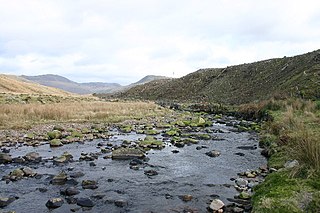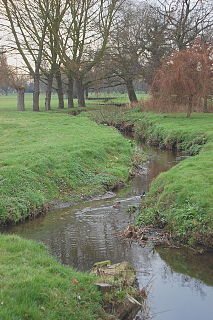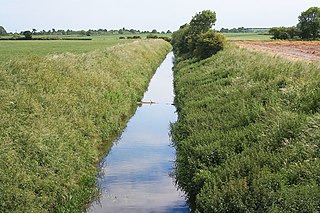Related Research Articles

The Tamar is a river in south west England, that forms most of the border between Devon and Cornwall. A part of the Tamar valley is a World Heritage Site due to its historic mining activities.

The River Blackwater is a tributary of the Loddon in England and sub-tributary of the Thames. It rises at two springs in Rowhill Nature Reserve between Aldershot, Hampshire and Farnham, Surrey. It curves a course north then west to join the Loddon in Swallowfield civil parish, central Berkshire. Part of the river splits Hampshire from Surrey; a smaller part does so as to Hampshire and Berkshire.

The Erme is a river in south Devon, England. From its source on Dartmoor it flows in a generally southerly direction past some of the best-preserved archaeological remains on the moor. It leaves the moor at the town of Ivybridge and continues southward, passing the settlements of Ermington, Modbury and Holbeton. Near Holbeton it becomes a ria and empties into the English Channel in Bigbury Bay, between the rivers Yealm and Avon.

The River Hyndburn is a minor river in Lancashire, England. Beginning as Woodnook Water on the slopes of Goodshaw Hill, it passes through Stone Fold, Rising Bridge and Baxenden where it is augmented by streams from Thirteen Stone Hill and continues to the Woodnook area of Accrington. Near St James Church, it collects Broad Oak Water, becoming the River Hyndburn.

The Meers Brook is a stream in Sheffield, England and one of the main tributaries of the River Sheaf. The Meers Brook originates in Gleadless and flows downhill through Gleadless Valley and Meersbrook then, culverted, continues underneath Heeley to pour into the River Sheaf near Saxon Road and Clyde Road in Lowfield.

The Blackburn Brook is a stream in Sheffield, South Yorkshire, England which flows through the Blackburn Valley along the M1 and Ecclesfield Road and joins the River Don near the Meadowhall shopping centre. Downstream from the A61 road at Chapeltown the Blackburn Brook is defined as a main river by the Environment Agency, which requires new building development to be at least 26 feet (8 m) from the bank side as a flood defence measure and to allow access to the watercourse for maintenance.

The River Cynon in South Wales is a main tributary of the Taff. Its source is the rising of Llygad Cynon at 219m above sea level at Penderyn, Rhondda Cynon Taf and flows roughly southeast, into the Taff at Abercynon in the same district. The water emerging at Llygad Cynon has been traced back to the sink of the Nant Cadlan at Ogof Fawr.

The River Bleng is a tributary of the River Irt in the county of Cumbria in northern England.

The River Roach is a river that flows entirely through the English county of Essex. It is one of four main streams that originate in the Rayleigh Hills to the west, and flow east. They then flow towards the centre of the Rochford Basin, a circular feature which may have been caused by an asteroid impact in the Late Oligocene or Early Miocene periods. To the east of Rochford, the river becomes tidal, and is governed by the Crouch Harbour Authority. It joins the River Crouch between Wallasea Island and Foulness Island. To the west of Rochford, there is some doubt as to which of the four streams is officially the Roach.

Little Bernera is a small island situated off the west coast of the Isle of Lewis in the Outer Hebrides.

Barlings Eau is a small river near Barlings, Lincolnshire, England. It is a tributary of the River Witham, joining it near Short Ferry. It acts as the central spine for a number of other small rivers, which drain the low-lying land to either side. Most of its course is within the area managed by the Witham Third District IDB, an Internal Drainage Board responsible for land drainage. One of their pumping stations is on the banks of the river.

The River Dysynni is a river in mid Wales. Its source is the Tal-y-llyn Lake just south of the Cadair Idris massif and its mouth is in the Cardigan Bay area of the Irish Sea to the north of Tywyn. It measures about 16 mi (26 km) in length.

The River Brora is an east-flowing river in Sutherland in the Highlands of Scotland. It is formed where its headwater streams, the Féith Osdail, Allt Gobhlach and Allt nan Con-uisge meet at Dalnessie, then flows southeastwards down Strath Brora to Dalreavoch. The river then briefly turns northeast and then east, before turning southeastwards once again to pass through the three distinct basins of Loch Brora to enter the Moray Firth on the North Sea at the town of Brora. Its one principal tributary is the Black Water which enters on its left bank at Balnacoil. The Black Water is itself fed by the River Skinsdale and the Coirefrois Burn.

Loch Mhòr is a loch in the traditional county of Inverness-shire in the Scottish Highlands. It occupies much of the wide floor of Stratherrick which runs roughly parallel to Loch Ness, around 3 mi (4.8 km) to its southeast. A generally shallow body of water 179 m (587 ft) above Loch Ness, Loch Mhòr achieves a depth in excess of 20 m (66 ft) towards its southern end.
The Afon Soch is a short river on the Llŷn peninsula, Gwynedd, Wales. It arises to the north of the village of Sarn Meyllteyrn, through which it then flows, turning southeast towards Botwnnog. Beyond Botwnnog it is joined by its main left-bank tributary, the Afon Horon, which rises to the east of Carn Fadryn. Their combined flow approaches the coast at Porth Neigwl but instead the river turns sharply northwards at Llanengan and curves around east to Abersoch where it enters the sea. A short section of the Soch valley is followed by the Wales Coast Path where it takes a route inland of Porth Neigwl. Both the Soch and the Horon are misfit streams within valleys that were formed by glacial meltwater. The river name is reckoned to be of Irish origin, the old Irish word 'socc' meaning a sow. There are a number of other Irish names in Llŷn.
Dunbeath Water is a short river in Caithness in northern Scotland. It rises at Loch Braigh na h-Aibhne in the Flow Country and initially flows northeast before turning generally south-southeastward to flow through Dunbeath and into the Moray Firth at Dunbeath Bay. Its main tributaries in its upper catchment are the left-bank ones of Allt a' Bhuic which drains Loch Dubh and the Raffin Burn which drains Loch Breac. On the western edge of Dunbeath, the Burn of Houstry, fortified by the Allt an Learanaich also enter on the north bank. The river is crossed by the old bridge and a new bridge carrying the modern A9 road northwards. A small harbour has been developed at the river mouth.
The River Strat is a river in the northernmost part of Cornwall in southwest England. The Strat flows for 12.7 miles to the sea at Bude, having risen to the south of Kilkhampton. It flows initially in a generally southwesterly direction through Stratton to a meeting with its major tributary, the River Neet at Helebridge. The river then turns abruptly to the north-northwest, parallel to the coast which it meets at Bude Haven. The Neet rises to the east of Week St Mary and flow north and northwest to its confluence with the Strat. Other of its tributaries rise to the west of Week St Mary. The section downstream from the vicinity of Helebridge is accompanied by the now disused Bude Canal. The rivers are home to trout, lamprey and eels. The Strat is sometimes also referred to as the River Neet. Older forms of the name of Stratton include Straetneat, one of the meanings of which may be the 'valley of the Neat'.
The Afon Erch is a short river on the Llŷn peninsula, Gwynedd, Wales. It arises near the village of Llanaelhaearn, flowing south and southwest towards the hamlet of Llwyndyrys where it turns abruptly eastwards and curves around to the south, passing to the east of Y Ffor at Rhyd-y-gwystl. It continues towarin a SSW direction towards Abererch where despite the village name, it does not enter the sea but flows west parallel to the coast for 1 mile to Pwllheli. The Afon Rhyd-hir joins the Afon Erch within the tidal basin of Pwllheli Harbour. Its headwaters gather to the south of Llithfaen and flow south past Llannor to approach Pwllheli from the west. It is joined by the Afon Penrhos immediately west of the town, having originated around the extensive bog of Cors Geirch, a national nature reserve. Parts of the courses of each of these rivers occupy valleys that were formed by glacial meltwater. The uppermost Penrhos is a misfit stream within its valley.
Strath Halladale is a strath in the traditional county of Sutherland in the north of Scotland down which the Halladale River flows to enter the Atlantic Ocean at Melvich Bay. It is followed by the A897 road between Forsinard and just short of Melvich where it joins the A836 north coast road, just east of Halladale Bridge, the lowest road crossing of the river. The headwaters of the river gather within The Flows National Nature Reserve and head northwest towards Forsinard. The flow is soon joined by the left bank tributaries of the Catsack and Ewe burns. The main tributary is the left-bank River Dyke or Abhainn Bheag which joins just south of the twin settlements of Trantlemore and Trantlebeg on the west and eastern sides of the valley respectively. There are a large number of broch ruins within Strath Halladale.
The River Dionard is a river in the historic county of Sutherland in northwest Scotland. It arises as the outflow from Loch Dionard which lies below the eastern side of Foinaven and flows north-northwest through Strath Dionard below that mountain's eastern flanks for 7km before turning north and then northeast towards the head of the Kyle of Durness. Its winding channel is exposed at low tide within the sands of this shallow firth which connects with the Atlantic Ocean on the north coast. The principal headwater stream feeding Loch Dionard is the Allt an Easain Ghill which passes through two lochans beneath Meall Horn; the upper Lochan Ulbha and the lower An Dubh-loch. The nearby Allt Eilidh a' Chleirich flows from a third lochan, Lochan Sgeireach. There are numerous other streams and lochans in the upper catchment. The Gualin National Nature Reserve has been established within the catchment.
References
- ↑ 444 Helmsdale & Strath of Kildonan (Map) (A ed.). 1:25,000. Explorer. Ordnance Survey. 2002. ISBN 0319233901.
- ↑ 450 Wick & The Flow Country (Map) (A ed.). 1:25,000. Explorer. Ordnance Survey. 2003. ISBN 0319233960.